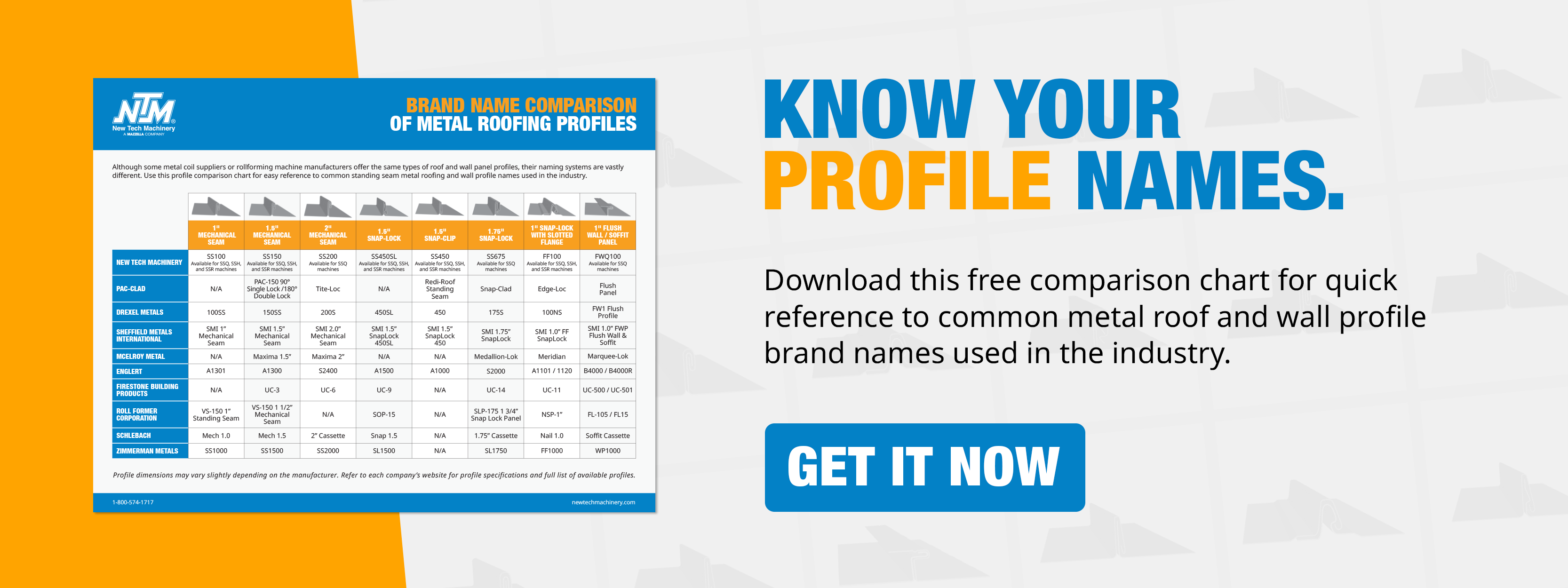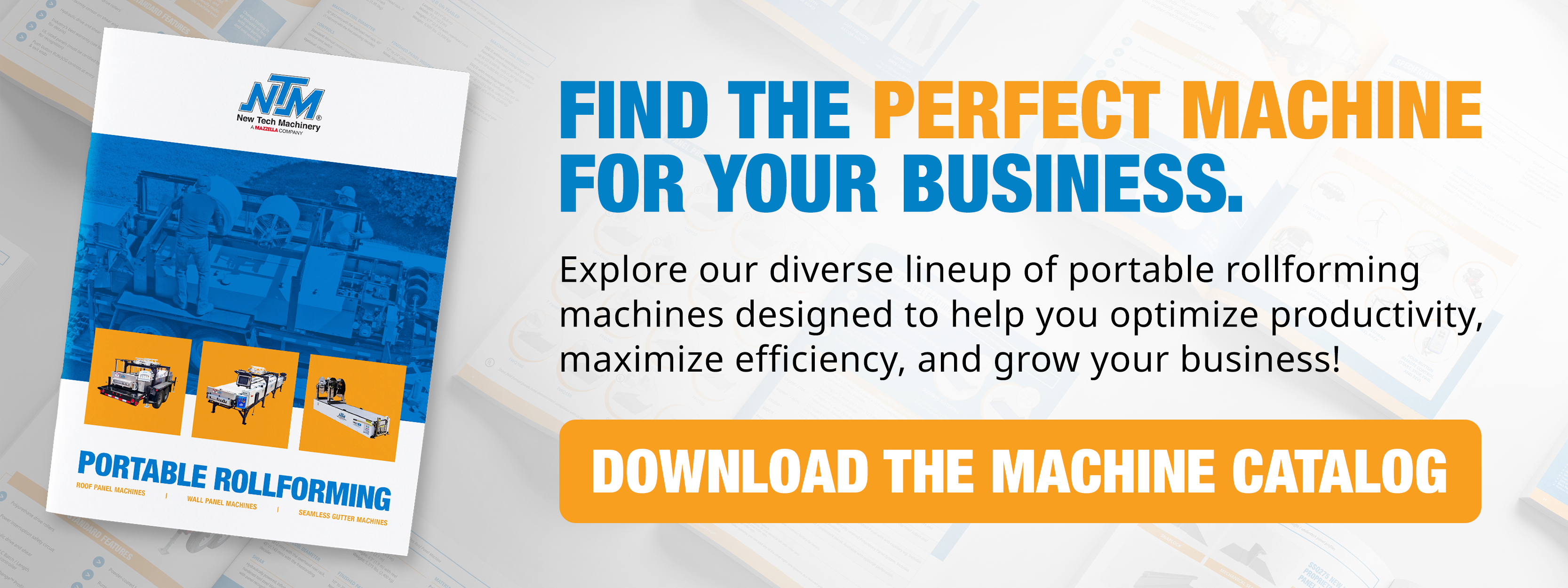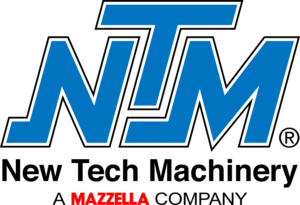“Added up, generative AI solutions could, in theory, help drive competitive advantages for organizations who get ahead of how to leverage and implement the technologies.” Forbes
The integration of Artificial Intelligence (AI) into numerous business sectors has been revolutionizing industries everywhere, and the metal roofing industry is no exception.
While AI applications have accelerated over the past year, you don’t have to understand how AI works to benefit from it. However, having a basic grasp of it will help you see its possibilities. While roofing is just on the precipice of the burgeoning technology, AI, with its advanced data processing capabilities and automation, is beginning to change how metal roofs are designed, manufactured, and installed.
At New Tech Machinery (NTM), we’ve helped metal contractors by providing the highest quality portable rollforming machines and machine support. We feel it’s important to educate our machine owners on operating their machines to their full potential. We also produce content highlighting the latest industry developments. This article explores the various ways in which AI is impacting the metal roofing industry.
In this article, we will cover:
- What is AI?
- Design & Customization
- Manufacturing Efficiency
- Installation Precision
- Supply Chain Optimization
- Environmental Impact
- Challenges & Future Prospects

What is AI?
Here’s a description of AI produced by ChatGPT 4 (in other words, AI describing itself):
Artificial Intelligence (AI) is a branch of computer science dedicated to creating systems capable of performing tasks that typically require human intelligence. These tasks include learning from experience (machine learning), recognizing patterns (pattern recognition), understanding natural language (natural language processing), solving problems, and making decisions. AI systems can process large volumes of data, identify trends, and learn from the data to improve their performance over time. Unlike traditional computer programs that follow strict, predefined instructions, AI algorithms can adapt and improve autonomously. This technology has broad applications, ranging from everyday tools like virtual assistants and recommendation systems to complex uses in healthcare, finance, autonomous vehicles, and robotics. The goal of AI is to augment or automate tasks to increase efficiency, accuracy, and to unlock new capabilities.
If that description sounds like a word salad, you’re not alone. Most of us lack a comprehensive understanding of how AI operates. All you really need to know is how it can save you time by doing some of the thinking for you. Chances are, you’re using it already with smartphone assistants, voice and facial recognition, automobile sensors, and even self-regulating thermostats that decide when to switch room temperatures as it learns your daily routine.
AI Applications
With new versions of ChatGPT and releases of Amazon’s Bedrock, Google’s Bard, and more, 2023 saw an explosion for generative AI, or large language model chatbots that produce written and data content, and text-to-image systems like DALL-E and Midjourney. AI is also popping up in software platforms like Hubspot and Salesforce, and all over social media. Tech giants like Google, Apple, and Microsoft are investing huge pools of money into developing AI in what can be described as a technological Gold Rush.
Computer language for coders has been streamlined thanks to AI, as it can generate source code. AI has adapted to robotics, business reporting and planning, project development, and more. AI is like a student, constantly learning new skills and applications.
It’s used in sports when statistical analysis can determine the likely outcome of a play. AI simulates possible game situations, develops strategies, and generates game plans based on everything from player biometrics to team performance data to the competition’s past game schemes and behaviors. AI gives a competitive edge to coaches of all sports.
Likewise, contractors can save time and gain a competitive advantage by using AI systems that can take information requiring hours or days to process and make determinations in seconds. In roofing, the possibilities are just developing. AI drones that can measure roofs and download data into a controller for exact panel measurements are already being used. AI can assist with generating estimates, enhancing safety practices, inspecting and monitoring roof conditions, managing inventory, scheduling jobs, providing visual models, implementing designs, producing marketing plans, supporting hiring efforts, and more.

Design and Customization
AI-Driven Design Software
One of the most visible impacts of AI in the metal roofing industry is in the realm of design. AI-powered design software can analyze architectural drawings and environmental data to suggest optimal roofing solutions. These tools can rapidly generate designs that maximize energy efficiency, sustainability, and aesthetic appeal.
AI design software can produce 3D models of roofs based on measurements and drone images. The software can illustrate to consumers how different material designs and colors will look before they choose their roofs.
AI technologies powering virtual reality (VR) and augmented reality (AR) can allow roofers to detect roof abnormalities and damage, and provide exact measurements for slopes, cutting down on material waste. Just imagine examining a roof in granular detail through VR goggles.
AI can diagnose and provide solutions to problems related to roofing and installation. For example, if you’re installing a metal roof in an area prone to high wind or hail, AI can recommend materials, coatings, and installation techniques that will best protect the roof from adverse conditions, also considering the slope, substrate, and other architectural elements. AI can analyze installation progress and workmanship quality.

Customization
AI algorithms can process vast amounts of data to offer highly customized roofing solutions. They can take into account factors like local weather patterns, building codes, and specific client preferences to create tailored designs.
AI can use historical data to determine the likelihood of a severe weather event and how to best prepare for it. It can advise on the best strategy given the statistical probability for varying factors. This translates to the right roof for the given conditions.
AI can also factor in LEED requirements, sustainability, and energy efficiency, including the best placement of solar panels for generating power. AI can assess roofing materials for eco-friendliness.

Manufacturing Efficiency
Estimates
AI measurements and analysis can consider types of materials, measurements, weather and climate conditions, labor costs, and other variables to generate accurate pricing for the customer. AI can even predict future maintenance costs based on the information.
Predictive Machine Maintenance
AI enhances manufacturing efficiency through predictive maintenance of rollforming equipment. By analyzing data from sensors on equipment, AI can predict when a machine needs servicing, reducing downtime. It can also send reminders for scheduled maintenance and alerts if a machine component isn’t functioning correctly.
While these AI diagnostic tools may not yet exist for rollforming machines, the future promises more sensor systems and seamless platform integration.
Quality Control
AI systems are increasingly being used for quality control. As mentioned, AI drones can inspect finished roofing materials more consistently and accurately than human inspectors. This not only improves product quality but also speeds up the production process.
It can also inspect the quality and efficiency of a crew by assessing skill levels and productivity. This gives the contractor insight into knowledge gaps that can be addressed by further training.

Installation Precision
Drone Technology
Drones, combined with AI, are transforming roof installation. Drones can survey a building site and collect data that is then used by AI algorithms to plan the installation process. This results in more accurate fittings and reduces the risk of human error while cutting down on material waste.
Safety Enhancements
AI also enhances safety on the worksite. AI-powered robots can perform risky tasks, such as maintenance at dangerous heights and eliminating accidents. AI drones can inspect roofs for damage and assess their condition in exact detail, as they can learn to quickly identify roof abnormalities.

Supply Chain Optimization
Inventory Management
AI systems optimize inventory management by predicting demand for various materials, ensuring supplies are available when needed without overstocking. It can track material usage and send alerts when stock is low for an item.
Logistics Optimization
AI helps optimize logistics and delivery schedules, ensuring timely delivery of materials, which is crucial for project timelines. It can manage scheduling by factoring all aspects of job completion and labor (including the metrics of individual worker productivity) and give a close approximation of when a job will be completed.
Using AI for project management can save contractors and team leaders huge amounts of time. What can take hours of calculating takes an AI system mere seconds.
Environmental Impact
Energy Efficiency
AI-driven design tools can optimize roof designs for energy efficiency, contributing to the construction of greener buildings. AI can produce a plan using eco-friendly and LEED-rated materials for LEED certification.
Material Usage Optimization
AI can also help reduce waste by optimizing the use of materials during the manufacturing process, generating exact measurements and material needs, and saving cost and time for the contractor.

So, What Challenges Come with Using AI?
Integration Challenges
Despite the advantages, integrating AI into existing systems poses challenges, including the need for significant investments and training for workers. AI requires an investment in technology, including software platforms, drones and other equipment, access to databases, etc. It also may take some time and skill to load the data and produce prompts.
Also, to integrate AI into machines may impact equipment costs. Advancing technology comes with a price tag. However, you may have options as to what you want on your machine. For that, we’ll have to wait and see.
Future Trends
Looking ahead, AI will likely become even more sophisticated and integrated, with the potential for fully automated manufacturing facilities and even more advanced data analytics for custom designs.
Like many industries, roofing is on the threshold of AI. 2023 saw an explosion of AI systems and their applications. It’s hard to imagine what the future holds, but fusing new technologies that include project planning and management, reporting and accounting, and more is already developing.
We’ve seen the emergence of smart roof technology that integrates sensors into the roofing system for monitoring roof conditions and panel health, recording weather patterns, regulating temperature, and interacting with solar panels, providing more sustainable and longer-lasting roofs. As metal roof and siding continue to emerge as a go-to for homeowners and commercial developers, technological advances will help contractors meet the growing demand.
Is there a danger to using AI?
It’s fair to say there’s a lot of concern about the negative potential of AI. Some are worried their jobs will be replaced by this emerging technology. Others fear scams, fake images, plagiarism, misinformation, and more.
While there are many unanswered questions regarding AI, most have little to do with roofing. It’s easier and safer to use a drone than put workers on a roof, but you still need someone to operate the drone who understands roofs and roof measurements. Also, while AI can generate extremely precise and reliable data on roof and panel measurements, it can’t do the job of installing a roof. It can, however, save contractors time and money.

Sharing Sensitive Information with AI
Be careful not to use AI for confidential information. An AI system may make the information accessible to those outside your company. AI is always learning, and you are one of its teachers. Anytime you input information into ChatGPT or another system, it can reference that information for someone outside your company. This may change over time as generative AI evolves into closed systems. For now, programs like ChatGPT, Bard, and others, are open to any users.
The integration of AI into the metal roofing industry is a transformative development. While it presents challenges, the benefits in terms of efficiency, customization, safety, and environmental impact are immense. As technology continues to advance, the potential for AI in this field seems boundless, promising even more innovative and efficient practices in the future.
At NTM, we strive to support your metal panel and gutter operations. To access more informative articles and videos, check out the NTM Learning Center. For valuable downloadable content, visit our resources page. To receive information on any of our portable rollforming machines, please contact us to speak with one of our specialists.
Sources:
Bolton, C. Is 2023 the Year of AI Transformation? Forbes, Feb. 8, 2023.
Cotney Consulting Group. AI’s integration into Roofing Operations, Metal Coffee Shop, Dec. 5, 2023.
McGrath, M.P. Emerging Technologies in the Metal Fabrication Industry, Metal Architecture, Oct. 11, 2023.
The Future of Roofing: Exploring Smart Roof Technology, Roof Evolution, Sept. 24, 2023.

